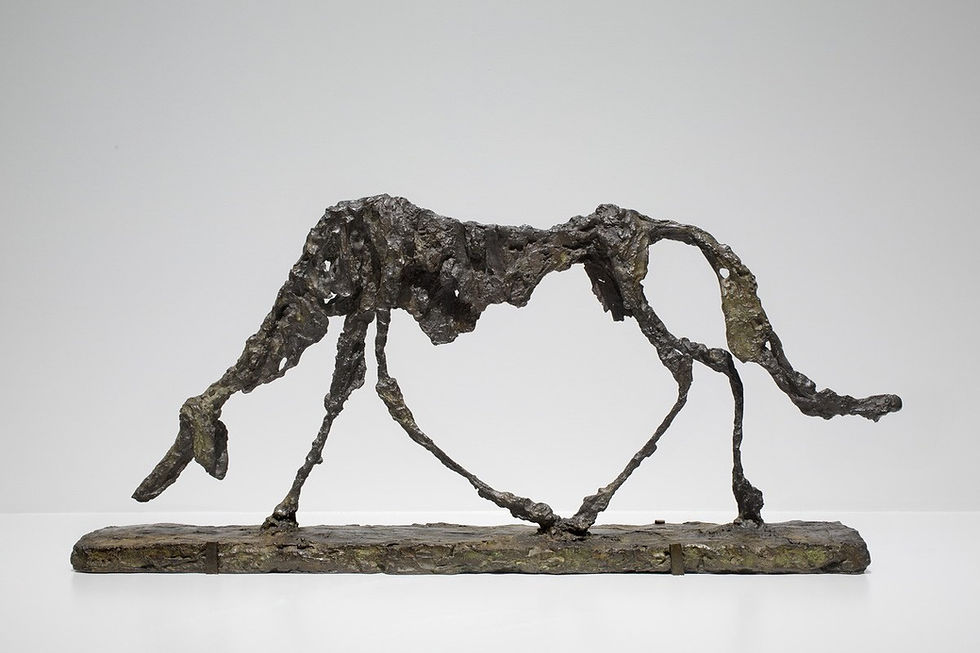GIACOMETTI EN EL GUGGENHEIM DE NUEVA YORK
- The Trendy Man
- 12 sept 2018
- 3 Min. de lectura
Actualizado: 20 nov 2019

Os confesaré que entré en el Guggenheim de Nueva York para ver su colección permanente de Arte Contemporáneo y me encontré con uno de esos regalos inesperados que, de vez en cuando, la vida de ofrece; ver la mayor exposición que se ha hecho de Giacometti, uno de los pocos escultores surrealistas que han hecho historia.
Fijaos en sus esculturas estilizadas, inquietantes, pequeñas, frágiles, pero asentadas con fuerza en enormes pedestales. El decía que no le importaba el tamaño natural de la gente que esculpía sino su mirada. Ahí es donde residía el alma de sus personajes.
Justo hoy acaba la muestra aquí en el Guggenheim de Nueva York y en breve viajará al museo gemelo de Bilbao donde estará expuesta unos meses.
No os dejará indiferente.
I'll confess that I got into Guggenheim Museum in New York City to enjoy its permanent collection of Contemporary Art and I found one of those unexpected gifts that, from time to time, life offers yo you; see the major retrospective of one of the twentieth century’s most significant artists: Giacometti, a painter and sculptor who sought the core of life – the alienation, and isolation, the terror of living, of walking through modernity, its cities, and city squares, its lonely crowds, its stricken men and women.
The exhibition featured more than one hundred and seventy-five sculptures, paintings, and drawings, spanning more than forty years and across all the various media with which he worked.
Today it closes in NYC but in a month the exhibition is traveling to Bilbao, Spain, to reopen its doors. Do not miss it.


La figura humana fue una obsesión para el artista suizo que murió en 1966. Según cuentan, posar para él era una prolongada tortura de quietud que se repetía días y días. Es por eso que sus mejores modelos fueron sus más cercanos y allegados como su propia mujer, Annete, su hermano Diego y varias de sus amantes como la joven prostituta Caroline.
Si os fijáis bien es muy curioso observar como sus hombres caminan y sus mujeres permanece estáticas como deidades totémicas. En su extensa carrera artística lo probó casi todo; fue naturalista, cubista, surrealista...en definitiva, único.
The exhibition reveals an obsessive artist, one who returned again and again to the same motifs, including cages and bars; wiry, naked human figures, with outsized feet, sometimes in movement, sometimes utterly still and erect – but ultimately they are homeless, living in a “no-man’s land… lost in infinite nothingness.”
Alberto Giacometti (1901-1966) was born in the Swiss village of Borgonovo, the eldest son of Giovanni Giacometti, a recognized post-impressionist painter. In 1922 he moved to Paris and quickly joined the Parisian avant-garde movement. He would remain in Paris for the majority of his life. His early work experimented with cubism; and in 1930, under the influence of André Breton, he would join the surrealists.



Dicen que Giacometti trabajaba rápido, de noche y sin descanso. Agarrado a su pitillo, de pie, a una distancia siempre fija de su figura en barro. Hacía y deshacía, les quitaba tanta materia que las destruía y empezaba desde cero. Era su carrera en solitario frente a la obra de arte. Sólo escuchaba, con los ojos cerrados como si fuera un invidente leyendo en Braile, los dictados del fondo de su memoria.
Al final regaba la figura con agua para devolverle la maleabilidad y seguir dotándola aún de más crudeza y de una terminación bellísima. Al final ya no eran ni hombres, ni mujeres, ni tienen edad, ni vestido, ni raza.
His work is not about creating beautiful or enjoyable objects, it is not about producing pleasurable experiences or delighting the viewer. Indeed, in some cases his work seems designed to do quite the opposite: to cause us discomfort, to make us uneasy, to make us feel the anguish and the burden of existence. Giacometti’s art is essentially a tragic one: there is little relief, even less humor – his is an art that returns compulsively to the beginning, seeking simply to start, to commence truthfully.






Como os dije al principio del post, la exposición acaba de cerrar justo hoy en el Museo Guggenheim de Nueva York pero viaja rumbo al de Bilbao donde está previsto que el 19 de octubre reabra sus puertas hasta el 24 de febrero de 2019
Si tenéis la oportunidad no dejéis de verla. Ya se anuncia a bombo y platillo como uno de los “must” de la próxima temporada.
As I told you before , the exhibition just closed today at the Guggenheim Museum in New York but travels to Bilbao where it is scheduled to reopen on October 19 until February 24, 2019
If you have the opportunity, do not forget to see it. It’s being announced as one of the “must-see" of the next season.

LO QUE LLEVO PUESTO ES DE MANGO. LOS SNEAKERS DE PUMA.
WHAT I AM WEARING IS FROM MANGO. SNEAKERS FROM PUMA



Comments